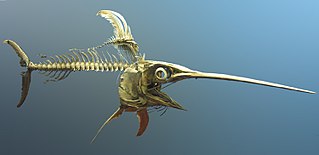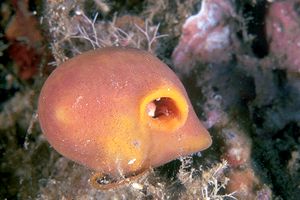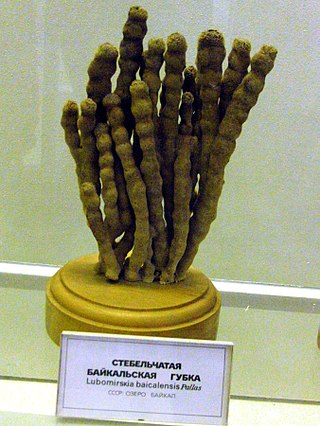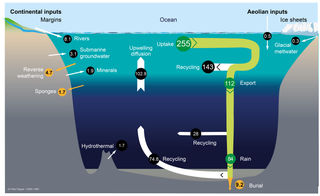
A diatom is any member of a large group comprising several genera of algae, specifically microalgae, found in the oceans, waterways and soils of the world. Living diatoms make up a significant portion of the Earth's biomass: they generate about 20 to 50 percent of the oxygen produced on the planet each year, take in over 6.7 billion tonnes of silicon each year from the waters in which they live, and constitute nearly half of the organic material found in the oceans. The shells of dead diatoms can reach as much as a half-mile deep on the ocean floor, and the entire Amazon basin is fertilized annually by 27 million tons of diatom shell dust transported by transatlantic winds from the African Sahara, much of it from the Bodélé Depression, which was once made up of a system of fresh-water lakes.

Sponges, the members of the phylum Porifera, are a basal animal clade as a sister of the diploblasts. They are multicellular organisms that have bodies full of pores and channels allowing water to circulate through them, consisting of jelly-like mesohyl sandwiched between two thin layers of cells.

Hexactinellid sponges are sponges with a skeleton made of four- and/or six-pointed siliceous spicules, often referred to as glass sponges. They are usually classified along with other sponges in the phylum Porifera, but some researchers consider them sufficiently distinct to deserve their own phylum, Symplasma. Some experts believe glass sponges are the longest-lived animals on earth; these scientists tentatively estimate a maximum age of up to 15,000 years.

The Venus' flower basket is a glass sponge in the phylum Porifera. It is a marine sponge found in the deep waters of the Pacific ocean, usually at depths below 500 meters. Like other sponges, they feed by filtering sea water to capture plankton and marine snow. Similar to other glass sponges, they build their skeletons out of silica, which forms a unique lattice structure of spicules. The sponges are usually between 10 cm and 30 cm tall, and their bodies act as refuge for their mutualist shrimp partners. This body structure is of great interest in materials science as the optical and mechanical properties are in some ways superior to man-made materials. Little is known regarding their reproduction habits, however fluid dynamics of their body structure likely influence reproduction and it is hypothesized that they may be hermaphroditic.

An endoskeleton is a structural frame (skeleton) on the inside of an animal, usually composed of mineralized tissue and overlaid by soft tissues. Endoskeletons serve as structural support against gravity and mechanical loads, and provide anchoring attachment sites for skeletal muscles to transmit force and allow movements and locomotion.

Demosponges (Demospongiae) are the most diverse class in the phylum Porifera. They include greater than 90% of all species of sponges with nearly 8,800 species worldwide. They are sponges with a soft body that covers a hard, often massive skeleton made of calcium carbonate, either aragonite or calcite. They are predominantly leuconoid in structure. Their "skeletons" are made of spicules consisting of fibers of the protein spongin, the mineral silica, or both. Where spicules of silica are present, they have a different shape from those in the otherwise similar glass sponges. Some species, in particular from the Antarctic, obtain the silica for spicule building from the ingestion of siliceous diatoms.

Biogenic silica (bSi), also referred to as opal, biogenic opal, or amorphous opaline silica, forms one of the most widespread biogenic minerals. For example, microscopic particles of silica called phytoliths can be found in grasses and other plants.

The siliceous sponges form a major group of the phylum Porifera, consisting of classes Demospongiae and Hexactinellida. They are characterized by spicules made out of silicon dioxide, unlike calcareous sponges.

Suberites domuncula is a species of sea sponge belonging to the family Suberitidae.

Thalassiosira pseudonana is a species of marine centric diatoms. It was chosen as the first eukaryotic marine phytoplankton for whole genome sequencing. T. pseudonana was selected for this study because it is a model for diatom physiology studies, belongs to a genus widely distributed throughout the world's oceans, and has a relatively small genome at 34 mega base pairs. Scientists are researching on diatom light absorption, using the marine diatom of Thalassiosira. The diatom requires a high enough concentration of CO2 in order to utilize C4 metabolism (Clement et al. 2015).

Siliceous ooze is a type of biogenic pelagic sediment located on the deep ocean floor. Siliceous oozes are the least common of the deep sea sediments, and make up approximately 15% of the ocean floor. Oozes are defined as sediments which contain at least 30% skeletal remains of pelagic microorganisms. Siliceous oozes are largely composed of the silica based skeletons of microscopic marine organisms such as diatoms and radiolarians. Other components of siliceous oozes near continental margins may include terrestrially derived silica particles and sponge spicules. Siliceous oozes are composed of skeletons made from opal silica SiO2·nH2O, as opposed to calcareous oozes, which are made from skeletons of calcium carbonate (CaCO3·nH2O) organisms (i.e. coccolithophores). Silica (Si) is a bioessential element and is efficiently recycled in the marine environment through the silica cycle. Distance from land masses, water depth and ocean fertility are all factors that affect the opal silica content in seawater and the presence of siliceous oozes.

Spicules are structural elements found in most sponges. The meshing of many spicules serves as the sponge's skeleton and thus it provides structural support and potentially defense against predators.

Suberites is a genus of sea sponges in the family Suberitidae. Sponges, known scientifically as Porifera, are the oldest metazoans and are used to elucidate the basics of multicellular evolution. These living fossils are ideal for studying the principal features of metazoans, such as extracellular matrix interactions, signal-receptor systems, nervous or sensory systems, and primitive immune systems. Thus, sponges are useful tools with which to study early animal evolution. They appeared approximately 580 million years ago, in the Ediacaran.
Monorhaphis is a monotypic genus of siliceous deep sea Hexactinellid sponges. The single species is the type species Monorhaphis chuni, a sponge known for creating a single giant basal spicule (G.B.S.) to anchor the sponge in the sediments. The species was described by Franz Eilhard Schulze in 1904 from specimens collected by the German Deep Sea Expedition in 1898–1899. Monorhaphis is also the only genus in the monotypic family Monorhaphididae.

Lubomirskia baikalensis is a freshwater species of sponge that is endemic to Lake Baikal, Russia. It is commonly called the Lake Baikal sponge and it is the most abundant sponge in the lake, but all the approximately 15 species of sponges in the family Lubomirskiidae are restricted to Baikal.

Spongilla lacustris is a species of freshwater sponge from the family Spongillidae. It inhabits freshwater rivers and lakes, often growing under logs or rocks. Lacustris is a Latin word meaning "related to or associated with lakes". The species ranges from North America to Europe and Asia. It is the most common freshwater sponge in central Europe. It is the most widespread sponge in Northern Britain, and is one of the most common species of sponges in lakes and canals. Spongilla lacustris have the ability to reproduce both sexually and asexually. They become dormant during winter. The growth form ranges from encrusting, to digitate, to branched, depending upon the quality of the habitat.
Homaxinella balfourensis is a species of sea sponge in the family Suberitidae. It is found in the seas around Antarctica and can grow in two forms, either branching out in one plane like a fan or forming an upright club-like structure.

Lubomirskiidae is a family of freshwater sponges from Lake Baikal in Russia.

The silica cycle is the biogeochemical cycle in which biogenic silica is transported between the Earth's systems. Silicon is considered a bioessential element and is one of the most abundant elements on Earth. The silica cycle has significant overlap with the carbon cycle and plays an important role in the sequestration of carbon through continental weathering, biogenic export and burial as oozes on geologic timescales.
Oopsacas minuta is a glass sponge that is a member of the Hexactinellida. Oopsacas minuta is found in submarine caves in the Mediterranean. It is reproductive year-round. This species is a part of a class that are usually bathyal and abyssal. Meaning they grow at a depth over 200 meters. At this depth the temperature is low and constant, so silica metabolism is optimized. However, this species has been observed in shallow water. O. minuta have only been observed by exploring caves that trap cold water. The shape of the sponge is elongated, cylindrical and a little flared. It is between a few millimeters and 3.5 centimeters. O. minuta are white are held up with a siliceous skeleton. The spicules of the skeleton intersect in an intricate network. These spindles partially block the top of the sponge. There are no obvious oscules. The sponge is anchored or suspended from the cave by silica fibers. This class of sponge is different from the three other classes of Porifera. It differs in tissue organization, ecology, development and physiology. O. minuta belongs to the order Lyssacinosida. Lyssacinosida are characterized by the parenchymal spicules mostly being unconnected; this is unlike other sponges in the subclass where the spicules form a connected skeleton. The genome of O. minuta are one of the smallest of all the animal genomes that have been sequenced so far. Its genome contains 24 noncoding genes and 14 protein-encoding genes. The spindles of O. minuta have three axes and six points. This species does not have pinacocytes, which are the cells that form the outer layer in other sponges. Instead of true choanocytes it has frill structures that bud from the syncytium.












